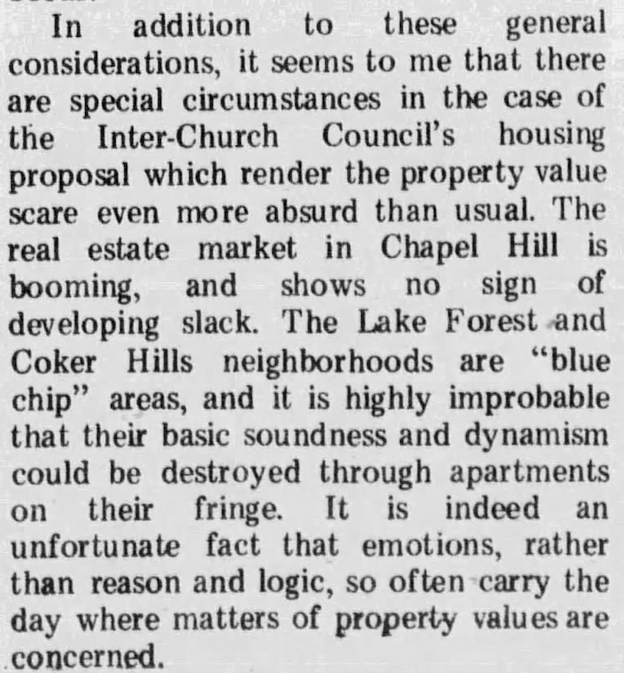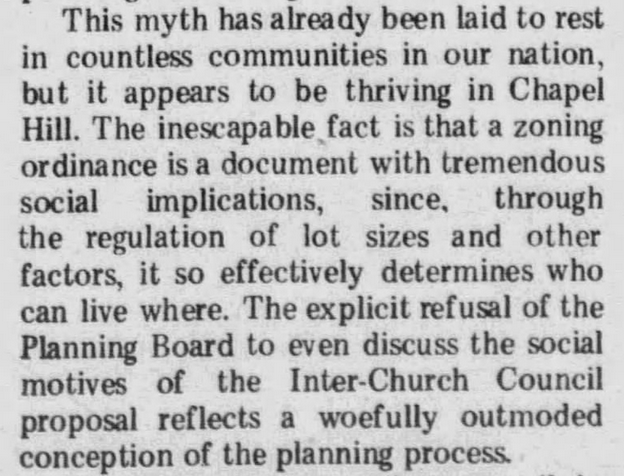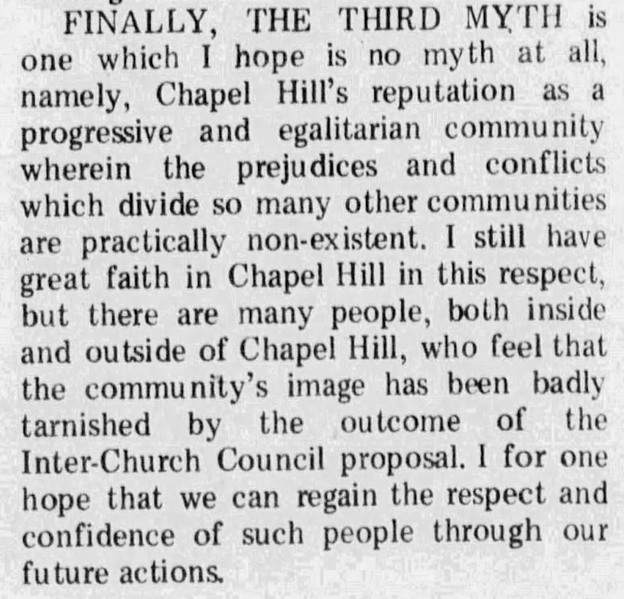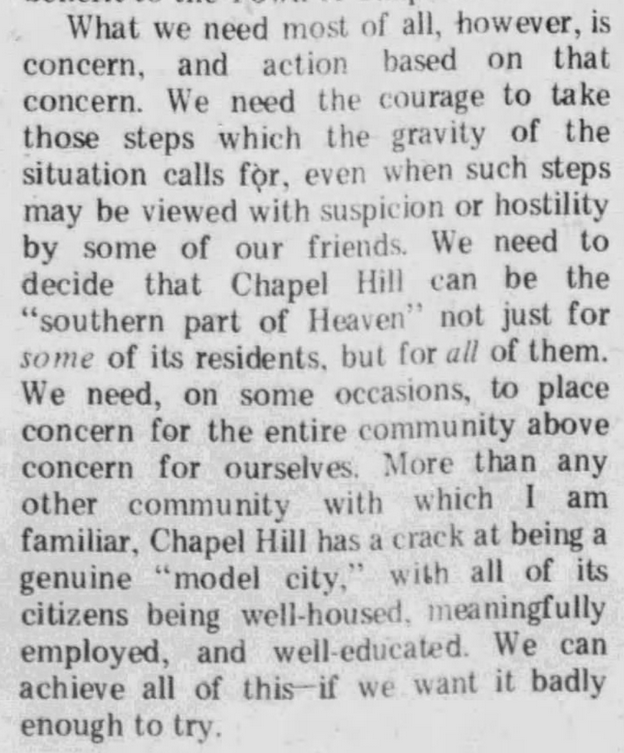We are publishing a six-part series looking back at Chapel Hill in 1968, and the lengthy and contentious battle to build duplexes and small apartments next to a church, and between a neighborhood of single-family homes and a shopping center.
Part 1: In-Chu Co and Missing Middle Housing: Chapel Hill’s Missing Middle Housing Battle in 1968
Part 2: In-Chu-Co: The protests start in 1968
Part 3: A push to build In-Cho-Co in Chapel Hill: ‘Is all of this Town’s vaunted liberalism phony?’
Part 4: Chapel Hill, 1968: The Death of Elliott Woods?
Part Four: Unlike now, the Chapel Hill Town Council continued meeting throughout the summer, so In-Chu-Co’s project quickly wound its way back to the council.
On Monday, August 26, a joint meeting of the Town Council and the Planning Board considered two low-income housing projects, both with about 40 homes. The first project, near the intersection of Estes Drive and Fordham Boulevard, was easily approved. The second was In-Chu-Co.
Despite some minor modifications to the project, including “buffer strips” separating the development from the 1-acre lots in Coker Hills and Lake Forest, opposition was just as fierce as it was months earlier. Petitions were presented, arguments were rehashed, and the proposal was again sent back to the Planning Board for further consideration. A few weeks later, on September 9, the Chapel Hill Town Council heard the proposal for what seemed like the last time.
![[newspaper top headline: Aldermen Split Bitterly in Decision. Main headline: Church Group’s Low-Rent Housing Plan Is Defeated]](https://triangleblogblog.com/wp-content/uploads/2023/03/Screenshot-2023-03-14-at-13-20-37-In-Chu-Co-Missing-Middle-Housing.png)
The headline said it all. Following a 4-3 recommendation from the Planning Board to disapprove the project, the Town Council voted 3-2 to put an end to the months-long debate. Alderman Gordon Kage, Roland Giduz, and Robert Varley all voted against the project, with council members Mary Protho and R.D. Smith, the council’s lone Black member, voting in favor (David Ethridge, who also supported the project, was absent).
In late October, Michael P. Brooks, a member of UNC’s department of City Planning and a supporter of In-Chu-Co’s proposal to build the Elliott Woods apartments, gave a speech to the Chapel Hill Rotary Club on what he learned from the defeat. In his remarks, which were reprinted in the Chapel Hill Weekly, Brooks reminded the audience that that the proposal was two years in the making, and was an attempt to take advantage of a section of the 1961 Housing Act, which provided low-interest loans to non-profit groups who were interested in building middle-income housing (the salaries earned by police officers, school teachers, and other service providers). The Inter-Church Council’s proposal was to build 100 homes, 50 for middle-income households and 50 for low-income households. Rather than build one large project, they wanted to build several small ones, and build them outside of existing pockets of poverty in town. The Elliott Woods site was chosen after more than a year of searching for the perfect location for the project.
After rehashing the history of the project’s ping-ponging between the council and the planning board in the summer, Brooks closed his speech by citing three “myths” that made it difficult to engage the public on this issue:
The myth that the mere presence of low-income and Black families would harm property values.
In the 1960s, the expectation that white families would move instead of live next to Black people was so ingrained that unscrupulous real estate speculators had created a strategy—called blockbusting—that preyed upon white racism and Black aspirations for upward mobility. Brooks reminded readers that there was little evidence for any link between the presence of affordable or public housing in a neighborhood and lower property values, and that the location of the In-Chu-Co homes was so desirable that to think they would drop in value was fantastical.

The myth that planning is a dry, technical art, best unburdened by concerns about social justice
For this point, Brooks seemed to be thinking primarily about members of the Chapel Hill Town Council (or, as it was then called, Board of Aldermen) and the Planning Board, some of whom claimed that their reluctance to grant a variance in this case was merely due to their commitments to the town’s zoning plan. As Brooks observed:

Brooks goes on to argue that all planning decisions benefit some groups, and harm others, and that it’s the role of politicians to weigh those factors when they make a decision.
The myth that Chapel Hill is a progressive community
By the 1960s, Chapel Hill had a reputation as a place with progressive values, with legislation like its open housing act underscoring the town’s standing as a liberal beacon in the South. But Brooks argued that at best, Chapel Hill was just like many other places and, at worst, especially problematic because of the hypocrisy of many of the town’s residents.

Addressing the Housing Crisis of 1968
Brooks closed his speech by recalling the reasons he and many others spent much time arguing for Elliott Woods in the first place. Chapel Hill had a housing shortage, and without addressing it, things would reach a crisis point at some point in the future. Observing that there was no one solution to our housing challenges, he called for many approaches, including:
- Programs to support the rehabilitation of existing homes
- Code enforcement to address substandard housing
- Emergency housing for families who are displaced
- Public housing
- Rental supplements for low-income families
- New apartments for moderate-income families built by non-profits
- Low-cost housing for people to buy
Brooks suggested that people also need to come together and face these challenges, not wish them away, or argue that other communities and neighborhoods should take on the burden of housing people. In closing he observed that solving the housing crisis was fundamental to making Chapel Hill live up to its aspirations.
